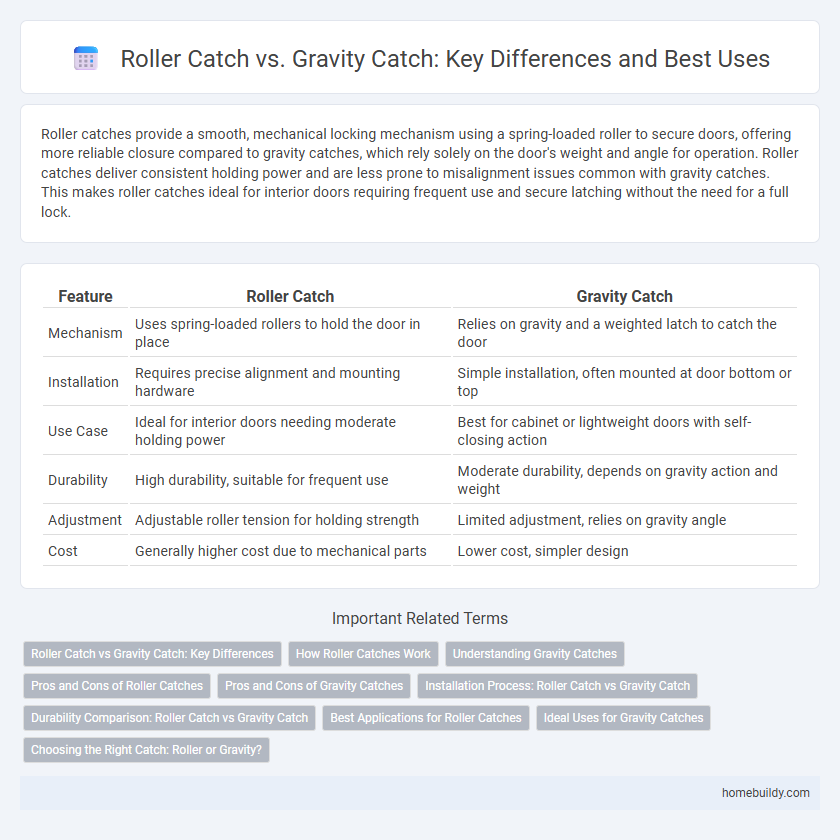Roller catches provide a smooth, mechanical locking mechanism using a spring-loaded roller to secure doors, offering more reliable closure compared to gravity catches, which rely solely on the door's weight and angle for operation. Roller catches deliver consistent holding power and are less prone to misalignment issues common with gravity catches. This makes roller catches ideal for interior doors requiring frequent use and secure latching without the need for a full lock.
Table of Comparison
| Feature | Roller Catch | Gravity Catch |
|---|---|---|
| Mechanism | Uses spring-loaded rollers to hold the door in place | Relies on gravity and a weighted latch to catch the door |
| Installation | Requires precise alignment and mounting hardware | Simple installation, often mounted at door bottom or top |
| Use Case | Ideal for interior doors needing moderate holding power | Best for cabinet or lightweight doors with self-closing action |
| Durability | High durability, suitable for frequent use | Moderate durability, depends on gravity action and weight |
| Adjustment | Adjustable roller tension for holding strength | Limited adjustment, relies on gravity angle |
| Cost | Generally higher cost due to mechanical parts | Lower cost, simpler design |
Roller Catch vs Gravity Catch: Key Differences
Roller catch uses spring-loaded rollers to secure doors, providing a smoother and more adjustable engagement compared to gravity catch mechanisms that rely on the door's weight for closure. Unlike gravity catches, roller catches offer consistent holding force regardless of door orientation, making them ideal for vertical and horizontal applications. The mechanical design of roller catches reduces wear over time, while gravity catches may lose effectiveness if the door's alignment shifts.
How Roller Catches Work
Roller catches secure doors using spring-loaded rollers that engage with a strike plate, providing a smooth, adjustable hold without a latch mechanism. Unlike gravity catches that rely on weight and alignment, roller catches maintain consistent tension through adjustable springs, enhancing door stability and ease of use. This mechanism ensures reliable closure in cabinetry, interior doors, and furniture applications where controlled resistance is essential.
Understanding Gravity Catches
Gravity catches rely on the natural force of gravity to securely hold doors closed, using a weighted mechanism that allows easy disengagement when pulled open. Unlike roller catches, which use spring-loaded wheels to grip the door, gravity catches offer a simpler design with fewer moving parts, reducing maintenance needs. Understanding gravity catches is essential for applications where silent operation and minimal wear are prioritized.
Pros and Cons of Roller Catches
Roller catches provide smooth and consistent door latching with minimal wear, making them ideal for lightweight doors and cabinets. Their adjustable tension offers better control over door closure compared to gravity catches, but they may require more maintenance due to moving parts susceptible to dirt and wear. Unlike gravity catches, roller catches do not rely on door position or natural force, ensuring reliable performance on uneven surfaces but can be less effective on heavier doors.
Pros and Cons of Gravity Catches
Gravity catches offer a simple mechanical solution with fewer moving parts, reducing maintenance and increasing durability compared to roller catches. They rely on weight and gravity to engage, which can limit their effectiveness on non-vertical surfaces or uneven installation, leading to inconsistent catching. While gravity catches provide a quieter and more subtle closure mechanism, they are less adjustable and may not provide the firm hold that roller catches achieve with their spring-loaded rollers.
Installation Process: Roller Catch vs Gravity Catch
The installation process of a roller catch involves securing the roller mechanism into the door and aligning it with the striker plate to ensure smooth engagement and release. In contrast, a gravity catch requires mounting the weighted latch and its corresponding strike, relying on gravity for closure, making placement accuracy critical for effective operation. Roller catches generally offer more precise adjustment options during installation compared to the straightforward setup of gravity catches.
Durability Comparison: Roller Catch vs Gravity Catch
Roller catches feature metal rollers that provide consistent pressure and wear resistance, resulting in superior durability compared to gravity catches, which rely on a weighted mechanism prone to weakening over time. The metal components in roller catches maintain their effectiveness through repeated use, whereas gravity catches often experience reduced functionality due to wear in the pivoting parts. Overall, roller catches are preferred in high-traffic environments where long-lasting performance is critical.
Best Applications for Roller Catches
Roller catches provide superior holding force and smooth operation compared to gravity catches, making them ideal for cabinet doors, closet doors, and lightweight panels that require secure closure without latching mechanisms. Their constant tension allows for consistent engagement regardless of door orientation, which is less reliable in gravity catches dependent on alignment for functionality. Roller catches are best applied in environments with frequent use and where moderate to firm retention is necessary, ensuring doors stay closed during vibrations or movement.
Ideal Uses for Gravity Catches
Gravity catches are ideal for applications requiring smooth, automatic door closure without manual intervention, such as cabinet doors or small access panels. They work best in installations where door weight and alignment allow the catch to engage through gravitational force, ensuring reliable holding without additional mechanical components. Compared to roller catches, gravity catches offer silent operation and are suited for lighter doors that benefit from gentle latching.
Choosing the Right Catch: Roller or Gravity?
Roller catches offer smoother, quieter operation with precise latching ideal for cabinet doors requiring minimal force and consistent engagement. Gravity catches rely on weighted mechanisms, providing reliable closure suited for heavier doors or applications where automatic release is needed without manual intervention. Selecting the right catch depends on door weight, usage frequency, and desired ease of operation, making roller catches preferable for finesse and gravity catches better for robust functionality.
Roller catch vs Gravity catch Infographic

 homebuildy.com
homebuildy.com